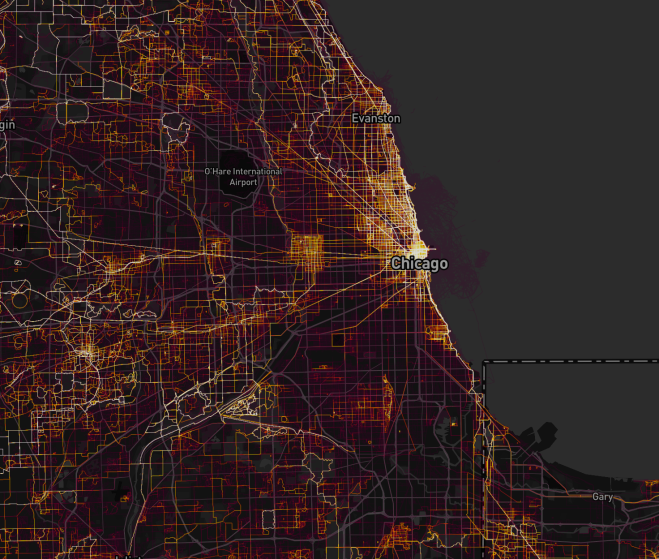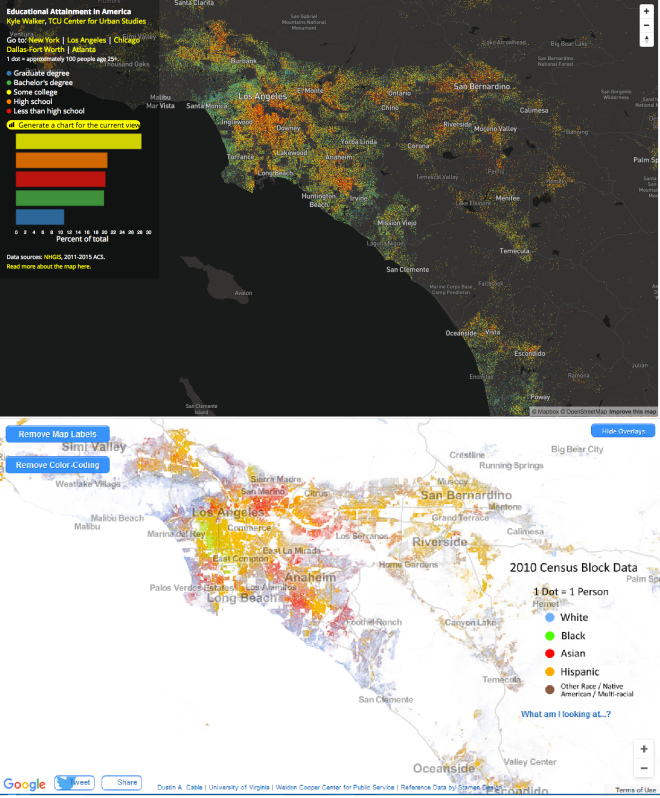A while ago, I wrote a post at Sociological Images looking at the ways Dustin A. Cable’s map visualizing racial segregation in the U.S. compared with Kyle Walker’s map examining educational segregation in the U.S. My interest was in was in examining spatial inequality. In a nutshell, where you live matters. It plays an important role in what kinds of resources you have access to (or don’t). It shapes your future earnings, how much education you’re likely to receive (in addition to the quality of that education), how long you live, and much more.
I was interested in putting the two maps into conversation because sociologists who study inequality are interested in a specific social process wherein privilege and inequality tend to accumulate. That is, some kinds and qualities of resources (economic, social, cultural) are found in abundance in some contexts, to a lesser extent in others, and are virtually absent in many places. And you can see these accumulations. Non-white populations (specifically Black and Hispanic) are in high concentrations on the maps in the same areas lower levels of education are present.
Last week, Runner’s World ran a story that looks at where people run according to Strava’s maps to talk about racial segregation and it reminded me of this post. I went through and looked up some of the big cities to see how where most popular routes are for runners using Strava. [Note: I run and do not use Strava, and many runners I know do not either. So, this is not a measure of exercise in a given area; it’s a measure of how many people exercise using Strava.]
If you’re unfamiliar, Strava is a mobile app and website on which runners and cyclists are able to post their exercise and connect with others doing the same. So, it’s basically a facebook page for people who exercise and want to log their miles to go online and hold themselves and each other accountable (and probably to brag a little too).
But look at how racial segregation, educational segregation and Strava use map onto one another! Below, is the map I created so that you can see San Francisco, Berkeley, and San Jose, California in the same frame using Walker’s map of educational attainment (top) over Cable’s racial dot map (bottom). [Note the legends on each map when deciphering the meanings.]

Here’s where people run using Strava in the same areas:

Here’s Chicago:

And Chicago’s Strava runners:

Los Angeles:

And L.A.’s Strava enthusiasts:

New York City:

NYC Strava users:

Detroit, Michigan:

Detroit Strava users:

and, finally, Houston, Texas:

And the Strava scene in Houston:

This could be an indication that white people are exercising more than are other groups (or, more accurately, that white people who exercise are simply a lot more likely to turn to Strava to tell everyone how much they exercised and where than are other racial groups). But it is also a kind of social network that people living in predominantly white areas seem to be tapped into that other groups are less likely to use (and part of this is both knowing about the Strava community and believing it would be worthwhile to join). It’s a social network white people seem to be using more than other groups. And that makes me wonder what else they might be getting from logging their extracurricular exercise on social media.
But it also made me think of Rashawn Ray‘s research on how varying racial compositions of neighborhoods influences Black men and women to engage in more of less physical activity in their leisure time. And it could provide a different kind of evidence for spatially-based health inequalities.
Segregation is one powerful way that inequalities persist–its also a way that many are kept blithely unaware of the existence of stark social inequalities. It can be hard to notice inequality when we’re segregated from each other (by race, class, education). But mapping where we run offers a powerful illustration of some of these inequalities – and the use of Strava is one small piece of how inequalities are sustained.

Interesting topic. However, as you noted this is merely correlation via descriptive visual assessment. Not scientific or reliable analysis by any means. The possibility and high probability that whites use Strava more often is almost certainly correct. Especially in terms of cycling. Black and other minority groups simply do not participate in that kind of activity.